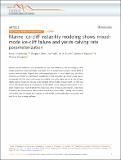Files in this item
Marine ice-cliff instability modeling shows mixed-mode ice-cliff failure and yields calving rate parameterization
Item metadata
| dc.contributor.author | Crawford, Anna | |
| dc.contributor.author | Benn, Douglas I | |
| dc.contributor.author | Todd, Joe | |
| dc.contributor.author | Åström, Jan | |
| dc.contributor.author | Bassis, Jeremy | |
| dc.contributor.author | Zwinger, Thomas | |
| dc.date.accessioned | 2021-05-17T11:30:08Z | |
| dc.date.available | 2021-05-17T11:30:08Z | |
| dc.date.issued | 2021-05-11 | |
| dc.identifier.citation | Crawford , A , Benn , D I , Todd , J , Åström , J , Bassis , J & Zwinger , T 2021 , ' Marine ice-cliff instability modeling shows mixed-mode ice-cliff failure and yields calving rate parameterization ' , Nature Communications , vol. 12 , 2701 . https://doi.org/10.1038/s41467-021-23070-7 | en |
| dc.identifier.issn | 2041-1723 | |
| dc.identifier.other | PURE: 274016716 | |
| dc.identifier.other | PURE UUID: aa085ece-5672-4a7d-9d5a-92a9fbd651cf | |
| dc.identifier.other | Jisc: fd206db3361d4ca484d403e603eec87f | |
| dc.identifier.other | Jisc: fd206db3361d4ca484d403e603eec87f | |
| dc.identifier.other | publisher-id: s41467-021-23070-7 | |
| dc.identifier.other | manuscript: 23070 | |
| dc.identifier.other | ORCID: /0000-0003-3183-043X/work/94291716 | |
| dc.identifier.other | ORCID: /0000-0002-3604-0886/work/94669201 | |
| dc.identifier.other | Scopus: 85105770475 | |
| dc.identifier.other | WOS: 000658724200016 | |
| dc.identifier.uri | https://hdl.handle.net/10023/23200 | |
| dc.description | This work is from the DOMINOS project, a component of the International Thwaites Glacier Collaboration (ITGC). DOMINOS is supported by the Natural Environment Research Council (NERC: Grant NE/S006605/1). This article represents ITGC Contribution No. ITGC-020. The model simulations were conducted with computational resources provided by NERC and PRACE. | en |
| dc.description.abstract | Marine ice-cliff instability could accelerate ice loss from Antarctica, and according to some model predictions could potentially contribute >1 m of global mean sea level rise by 2100 at current emission rates. Regions with over-deepening basins >1 km in depth (e.g., the West Antarctic Ice Sheet) are particularly susceptible to this instability, as retreat could expose increasingly tall cliffs that could exceed ice stability thresholds. Here, we use a suite of high-fidelity glacier models to improve understanding of the modes through which ice cliffs can structurally fail and derive a conservative ice-cliff failure retreat rate parameterization for ice-sheet models. Our results highlight the respective roles of viscous deformation, shear-band formation, and brittle-tensile failure within marine ice-cliff instability. Calving rates increase non-linearly with cliff height, but runaway ice-cliff retreat can be inhibited by viscous flow and back force from iceberg mélange. | |
| dc.format.extent | 9 | |
| dc.language.iso | eng | |
| dc.relation.ispartof | Nature Communications | en |
| dc.rights | Copyright © The Author(s) 2021. Open Access. This article is licensed under a Creative Commons Attribution 4.0 International License, which permits use, sharing, adaptation, distribution and reproduction in any medium or format, as long as you give appropriate credit to the original author(s) and the source, provide a link to the Creative Commons license, and indicate if changes were made. The images or other third party material in this article are included in the article’s Creative Commons license, unless indicated otherwise in a credit line to the material. If material is not included in the article’s Creative Commons license and your intended use is not permitted by statutory regulation or exceeds the permitted use, you will need to obtain permission directly from the copyright holder. | en |
| dc.subject | Glaciology | en |
| dc.subject | Calving | en |
| dc.subject | Ice failure | en |
| dc.subject | GB Physical geography | en |
| dc.subject | Geophysics | en |
| dc.subject | 3rd-DAS | en |
| dc.subject | SDG 14 - Life Below Water | en |
| dc.subject.lcc | GB | en |
| dc.title | Marine ice-cliff instability modeling shows mixed-mode ice-cliff failure and yields calving rate parameterization | en |
| dc.type | Journal article | en |
| dc.contributor.sponsor | NERC | en |
| dc.description.version | Publisher PDF | en |
| dc.contributor.institution | University of St Andrews. Environmental Change Research Group | en |
| dc.contributor.institution | University of St Andrews. School of Geography & Sustainable Development | en |
| dc.contributor.institution | University of St Andrews. Bell-Edwards Geographic Data Institute | en |
| dc.identifier.doi | https://doi.org/10.1038/s41467-021-23070-7 | |
| dc.description.status | Peer reviewed | en |
| dc.identifier.url | https://www.nature.com/articles/s41467-021-23070-7#Sec15 | en |
| dc.identifier.grantnumber | NE/S006605/1 | en |
This item appears in the following Collection(s)
Items in the St Andrews Research Repository are protected by copyright, with all rights reserved, unless otherwise indicated.

